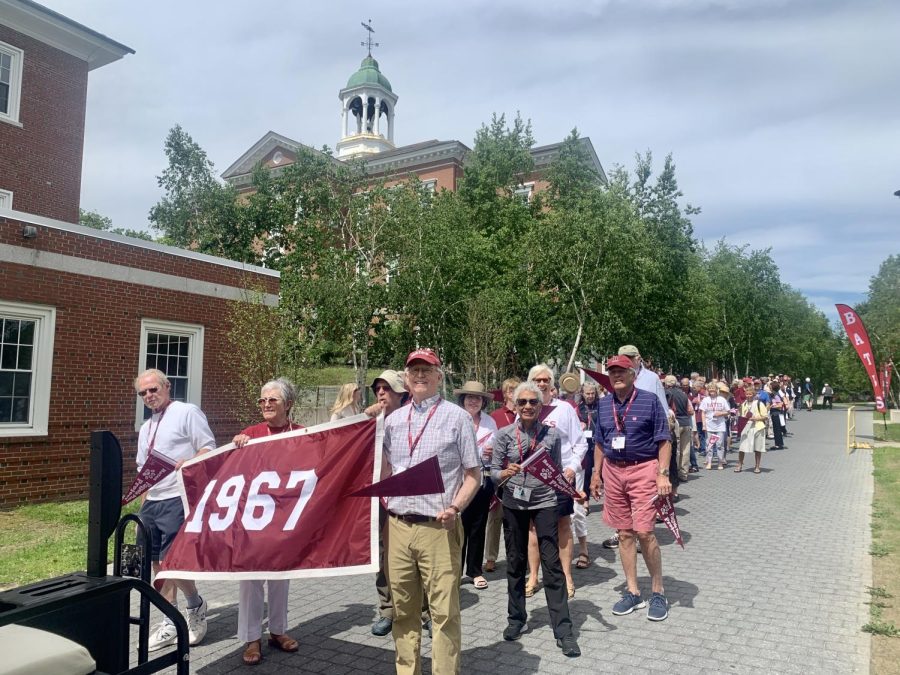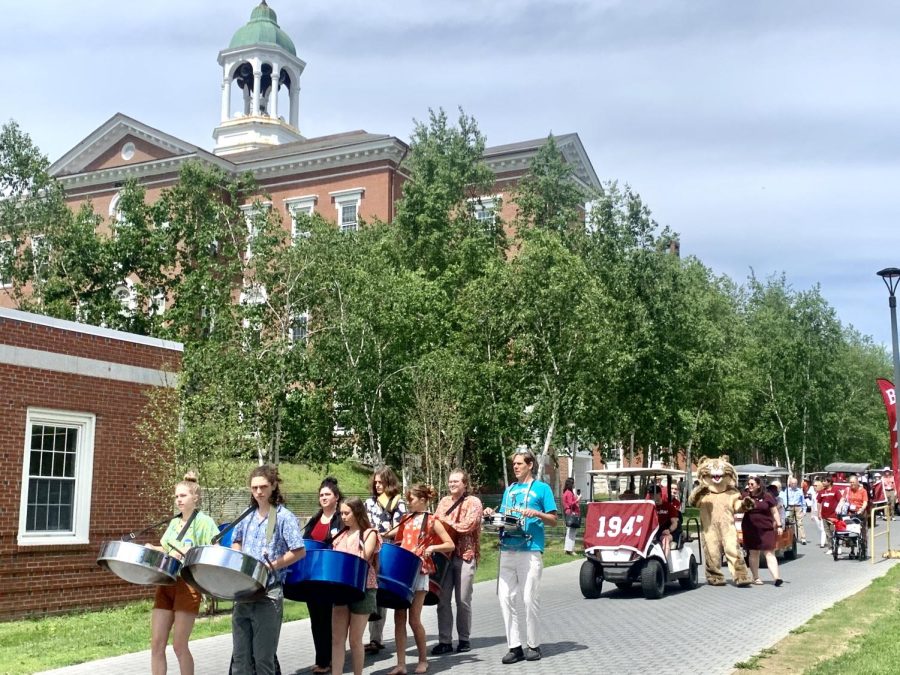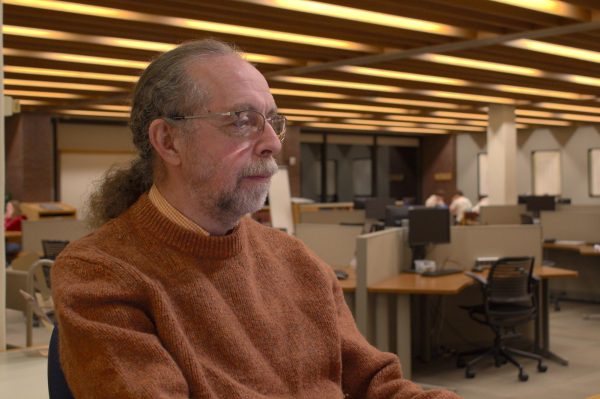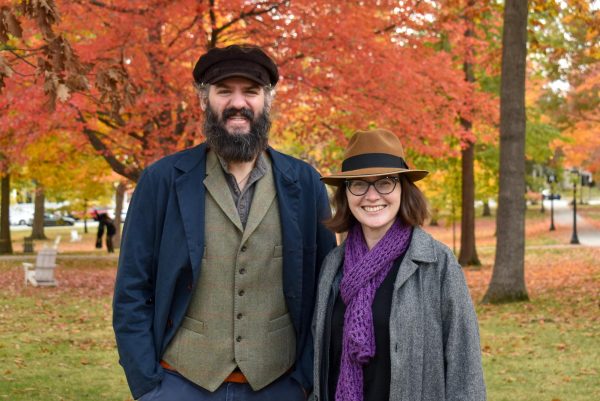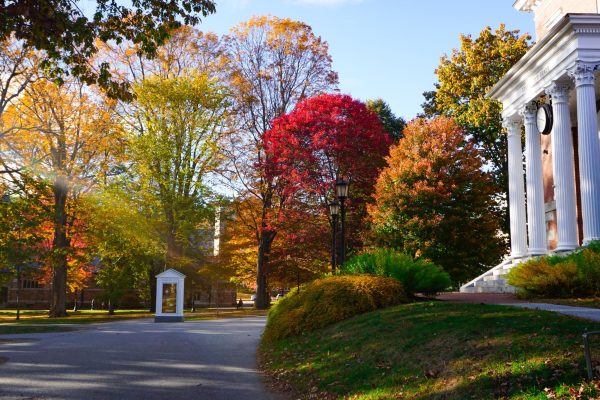Alumni from Across the Globe Reflect on Reunion and Bates
It’s been a while! It’s time for the reunion—Welcome back!
More than 1,200 alumni came to the reunion this year. Two thirds of them already graduated from Bates more than half a century ago. They came back to Lewiston from places all around the world, from Maine to California, from England to Egypt to Burma. Bobcats overcame the boundary and challenges of time and space–and finally got here, their spiritual home.
“My class had about 160 students,” Wallace W. Ryall III ’57 shared. “Many of my classmates already passed away now. Some of their spouses or children come to the reunion this time, so we have 16 people in the reunion, which is ten percent of the whole class, after 65 years of our graduation.”
This is the first in-person reunion after the outbreak of COVID-19. This year, reunion lasted for two weeks from June 3 to 12, covering classes ended with twos and sevens from the class of 1947 to the class of 2017, as well as the classes of 1995, 1996, 2015 and 2016 who didn’t come back for reunion in the past two years, and the class of 2020 who didn’t have in-person commencement because of the pandemic.
This is an exciting moment—Bates campus is filled with bobkittens of kindergarten-age to 100-year-old alumni; all of them belong to Bates. This is the time to retrospect on the past and write new chapters of Bates’ history: what Bates has been and has become.
Campus
This year, the oldest reunion classes live in the three newest residential halls on campus: Kalperis, Chu, and 280 College Street. They were all built after 2007. The question that has been asked most to the welcome center is: “where is 280? I have no idea what that is.” “Do you know where Rand is?” “Yes.” “Awesome! 280 is next to Rand Hall.” “Oh! That used to be a field.”
Coram Library is one of the oldest buildings on campus. Every Bates student’s college life starts and ends here at commencement.
“We went to Coram Library,” said Anne Harquail Perkins ‘82. “There were a few computers in the basement of Coram. I went there with a gallon of milk and some chocolate bars for my midterm. I got five midterm papers and had to go to Coram to use the computer. Most of us only had personal computers until our third year.” Back for her 40th reunion, Harquail Perkins studied economics and political studies.
The arrangement of the Bates campus hasn’t changed, but there are many new buildings.
“I went to Carnegie and Dana for my physics class,” recalled Wallace W. Ryall III ‘57. “Dana was all for the chemistry department, and the physics department was on the second floor of Carnegie. There were only two people in my class who majored in physics.”
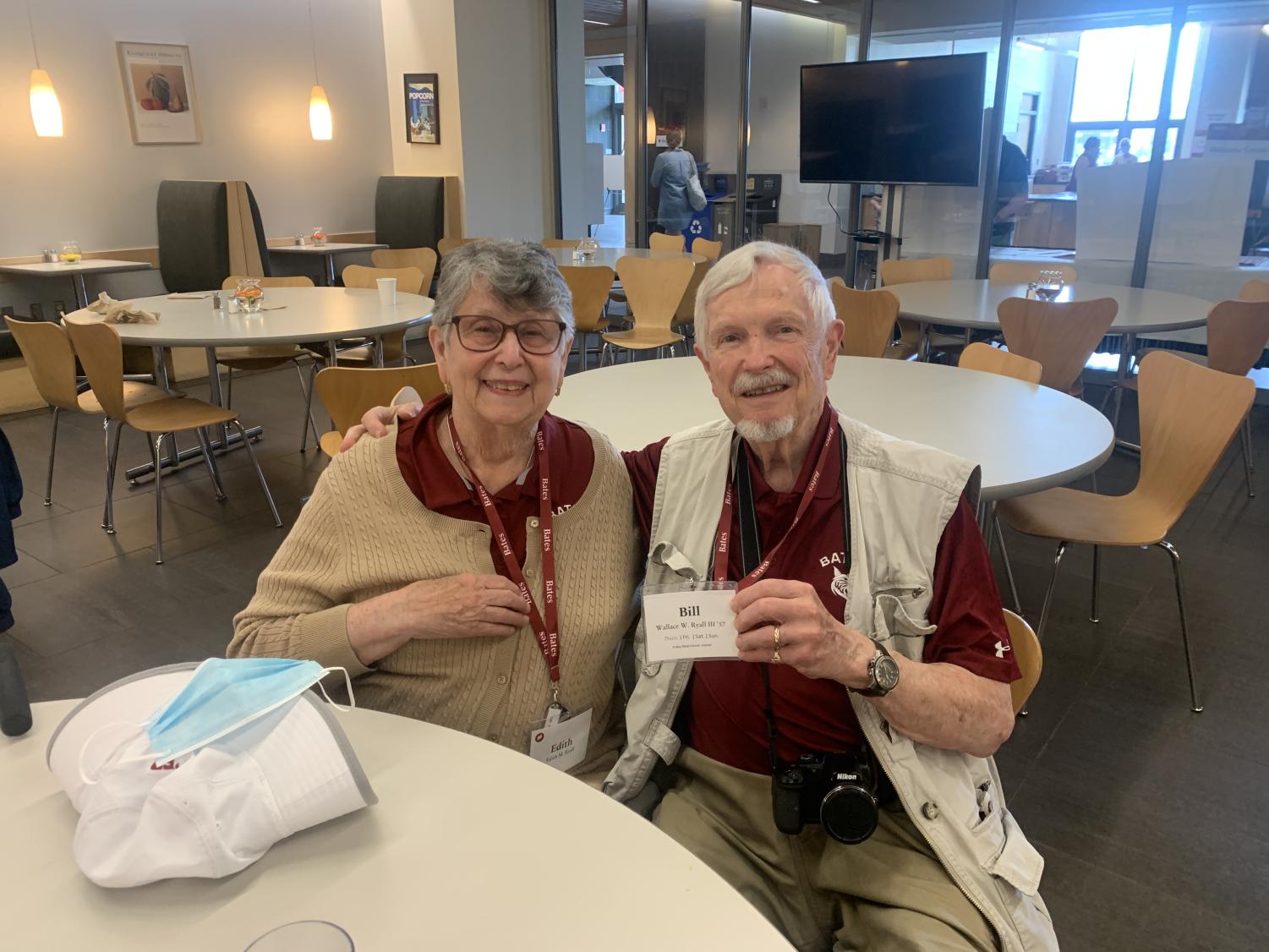
Back in the 1970s, Bates only had two buildings for science, Dana Chemistry Building and Carnegie Science Center. Bonney Science Center, the newly completed and transformative home for science at Bates, was opened last year. Therefore, a tour of the Bonney Science Center was also a featured event of the reunion this year.
Some buildings’ functions changed. Hedge Hall and Roger Willams Hall were both residential dorms back in the 1970s. Roger Williams was a party dorm. Hedge and Parker were all-men dorms in the 1960s. In the later 1970s, Hedge and Parker both became all-women dorms—male students couldn’t even access the door.
“Parker became a dorm only for senior women students in my senior year,” Helen J. O’Leary ’70 recalled; this also signals the increasing number of female students at Bates.
“There was a challenge in Parker: Go from the third floor to the ground floor without touching the floor, so you need to sit on the banister,” Richard M. Wood ’82, who majored in theater recalled.
Different residential halls at Bates have different personalities, formed through time and people.
“I lived in Clason House for my first year. It was a healthy living house, so no alcohol and no substance were allowed,” Zaw M. Oo ‘07 from Burma said. “We had 12 international students and 32 students in total live in Clason that year. We went to Chase Hall and ate together every day. They were the first group of friends I met at Bates!”
Having many international students has already become a tradition of Clason House. In the year 2021-2022, more than half of Clason’s residents were international students.
Food
The welcome dinner on Friday night this year served lobster, steak and vegan meals. Alumni can get a whole lobster, graduating students can get lobster rolls and students who haven’t graduated yet can only have seafood chowder with limited lobster meat in it.
Bates dining services are ranked as the top ten best college foods in the U.S. However, half a century ago, it was a different story.
“We could only have brownie once in two weeks, but now it seems Bates serves all kinds of desserts every day,” Wallace W. Ryall III ’57 shared.
New Commons was opened in February 2008. Before that, old Commons was located in Chase Hall. Memorial Commons in Rand Hall used to be a men’s dining hall. In 1950, couples were allowed to dine together in the Men’s Commons for the Sunday noon meal. It started to open to women students in 1967. Later on, however, the basement of Rand Hall became a small dining hall only for male students.
“I went to the basement of Rand once. They served chocolate milk and skimmed milk. We didn’t have that in Chase,” Janet Freudenberg Smith ’70 recalled.
“There was a small shop in the back of today’s Garcelon Field. They sell alcohol to Bates students, and it seems it’s still the same now,”Adam D. Pettengill ’82 shared.
A Co-Ed Experience
Most colleges in the U.S. back in the 1960s didn’t accept female students—Yale started to accept female students in 1969, and Bowdoin was still a male college in the early 1970s, so female applicants’ choices were limited. The 1970s was a big transition in the educational history of the U.S.: many colleges started to accept female students. However, Bates has always been a co-ed college since the moment it was established in 1855. Bates was the first co-ed college and conferred the first female undergraduate degree in New England.
“I chose Bates because it was one of a few co-ed colleges,” an alumna from the class of 1972 shared. “Yale [didn’t start] to accept female students until my second year at Bates. I also got accepted to Smith, but I went to visit the school. It was too small for me and all women. When I came here to visit Bates, I felt ‘that’s it! This is my home!’”
“I chose Bates because it’s co-ed, a liberal arts college, and I wanted to ski,” Janet Freudenberg Smith ’70 shared.
There was no college ranking back half a century ago, but Bates was a well-known college with affordable tuition.
“The tuition of my class was 500 dollars a semester,” Wallace W. Ryall III ’57 shared. “It was a rational price since it included the fees of boarding and meals.”
“Our full-tuition was 3,000 dollars a year,” Helen J. O’Leary ’70 recalled.
Bates also has become more international.
“We have 36 international students in my class. I’m from Burma, and I only went back to my home once during my four years at Bates,” Zaw M. Oo ’07 said. “Dean Reese would organize trips for international students. We went to Acadia and Boston. Some students who had cars would drive others.”
Bates now has more international students. The class of 2025 has more than 50 students from around the world. However, tradition remains: Dean Reese still drives students for short trips during breaks!
Sports
Sports are always important components of college life.
“I was not on the varsity team, but my friend, Martin, was the co-captain of the men’s football team in our class,” Wallace W. Ryall III ’57 recalled. “Our class, 1957, was famous for football because we beat the University of Maine. They were famous for football and won for many years, but in the year I graduated, we won! I still remember when the football team came back from the competition, everyone was cheering on the quad. Bates kept winning for several years after that. We started a new chapter of the history of Bates men’s football.”
Bates joined the New England Small Collegiate Athletic Conference (NESCAC) in 1971 as one of the charter members. Bates then constructed Merrill Gymnasium in 1980, which was built at a cost of approximately $6 million by the Architects Collaborative of Cambridge, Massachusetts.
“We didn’t have a swimming pool back then. We could only go to a fitness center in Auburn. It had a very small pool,” an alumna of the class of 1960 recalled.
“There were no Merrill Gym or Russell Street Field back then, but we had Gray Cage,” Anne Harquail Perkins ‘82 said. “The roof of Gray Cage was field and track, so we practiced on the third floor of the Cage.” She participated in the women’s track team and Outing Club, shared.
Final Thoughts
“What is the most unique characteristic of Bates students?”
“Joyful,” said Jean Labagh Kiskaddon ’47, P’71, P’75.
“Bates students are well-engaged in what they are doing,” said Lee K. Lim ’71
“Intelligent,” said Winnie Dennis Lim ’71
I worked as a BatesStar in the past two weeks, witnessing alumni and their families coming and going. When I found I was sad to see them leaving, I realized I had already become part of Bates, and Bates also became part of me.
There are always people at Bates. There are always Bates people.
Your donation will support the student journalists of Bates College and help us cover our annual website hosting costs.
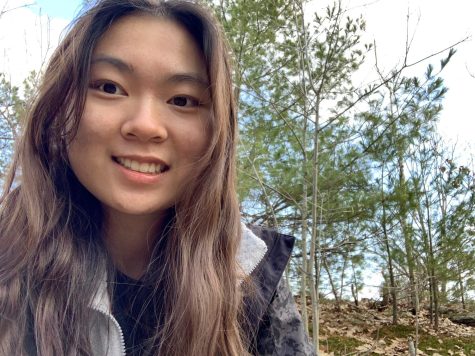
Willa Wang ’25 is a junior from Beijing, China, double majoring in history and philosophy with a minor in German. She is excited to work as the Managing...


